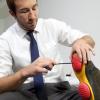Contents
- What is osteoarthritis?
- What factors increase the risk of developing osteoarthritis of the knee?
- How is osteoarthritis of the knee diagnosed?
- What are the symptoms of osteoarthritis of the knee?
- Is there a cure for osteoarthritis?
- How is osteoarthritis of the knee treated?
- Why is the knee such a common source of problems?
- What is biomechanics and how is it related to the development of knee osteoarthritis?
- Should I rest if my knee aches?
- Is there a way to slow down osteoarthritis progression?
- What is AposTherapy?
What is osteoarthritis?

Osteoarthritis (OA) is a chronic progressive disease that can affect any joint in the body. A key component of the disease is the wearing away process of the cartilage lining the bones that make up the joint. Cartilage helps the bones in the joint glide smoothly against each other. As the cartilage becomes worn the movement in the joint becomes less smooth. Joints that have to bear a greater load, such as the joints in your legs (which bear the weight of the body), have a greater risk of developing osteoarthritis. In the past two decades there has been a growing body of evidence showing that alongside the wearing away of the cartilage, the muscles around the joint can also begin to alter the way they work in an inefficient way. This inappropriate activity of the muscles, called bracing, increases the compression in the injured joint, decreases the joint’s range of motion and is now considered a detrimental factor in the initiation, progression and worsening of OA.
What factors increase the risk of developing osteoarthritis of the knee?
It has been shown that the greater the load on the joint, the greater the chances of that joint developing OA. In accordance with this, the joints in your legs, which bear the full weight of the body, have a greater chance of developing OA. The same is true of the small joints in the fingers that perform manipulative actions and can be put under pressure during our daily activities. Other factors that increase the load on the joints such as obesity and strenuous sporting activities, have also been implicated as risk factors. On the other hand, it is also widely accepted that inactivity, resulting in the weakening of the muscles, may also promote the wearing away of the cartilage. This is because the muscles play a crucial role in stabilising and controlling joints. A joint that is not properly stabilised performs an inharmonic movement and therefore tends to wear at a faster rate. Another important aspect of knee osteoarthritis is the way in which the loads are distributed inside the joint, i.e. the areas of the joint that bear the most weight have higher chances of developing OA. For example, people with bowed legs have a higher load on the inside of the knee, which makes the inside area of the knee more susceptible to developing OA. The inappropriate activity of muscles may also increase the load on the knee since overactive muscles compress the knee joint.
How is osteoarthritis of the knee diagnosed?
For many years doctors diagnosed OA in general, and knee OA specifically, by relying mainly on knee x-rays. An x-ray allows the doctor to see the bones which make up the knee joint, thus giving an indication of how much cartilage is left between the bone surfaces. Unfortunately, both studies and clinical experience clearly demonstrate that that the correlation between the severity of the pain and the severity of wear and tear seen in x-rays is not as strong as we would expect. Best practice in diagnosis and assessment will integrate the patient’s history, i.e. the pain and symptoms the patient reports, along with physical assessment findings and x-rays to make a more accurate diagnosis and more relevant assessment of the severity of the osteoarthritis. One of the most effective ways to objectively assess the severity of knee OA is to measure the patient’s ability to function normally. A good way to measure function is to measure the way the patient walks since walking involves both moving the legs and bearing the body-weight on each individual leg. By measuring the amount of time one spends on each leg during a step, physicians can estimate how much pain and disability that person experiences. This measurement can be obtained using a computerised gait assessment, a process which takes only a few minutes.
What are the symptoms of osteoarthritis of the knee?

The hallmark of knee osteoarthritis is pain in, and around the knee. Most patients also suffer from stiffness after prolonged periods of rest, particularly upon getting up in the morning. Some knee osteoarthritis sufferers also report weakness, instability or creaking in their knees. All these symptoms may appear in weight-bearing activities such as walking, standing and going up or down steps. Very often, these activities are limited by the symptoms of osteoarthritis, thus reducing the patients' quality of life.
Is there a cure for osteoarthritis?
To date, no medicinal cure has been found for knee osteoarthritis. Various treatments are used to reduce the symptoms of OA. These treatments include analgesics aimed to reduce pain, anti-inflammatory drugs aimed to reduce inflammation in the joint, as well as various surgical procedures, such as arthroscopy (keyhole surgery) aimed towards improving the smoothness of motion between the joint surfaces. Some of these treatments have short term benefits, but none of them actually rebuild the cartilage in the joint or restore the appropriate muscle activity required to stabilise the joint.
How is osteoarthritis of the knee treated?
There are a variety of medicinal and physical treatments for knee osteoarthritis. Medication may be prescribed with the aim of reducing the pain or reducing the inflammation in the joint. They are beneficial in the short term, and in some cases they are an appropriate treatment, but they do not cure the wear within the joint and they do not re-educate the muscles around the joint. Arthroscopies, which were once considered a treatment for knee osteoarthritis, are now only used for very specific cases. The reason for this is that a number of studies have shown that the benefits of any arthroscopic procedure followed by rehabilitation are no greater than rehabilitation alone. Due to the results of these studies, NICE (National Institute for Clinical Excellence) guidelines for the treatment of knee osteoarthritis now state that arthroscopies should be reserved only for cases of true ‘locking’ in the knee. The end-stage treatment for knee osteoarthritis is a total knee replacement, but this is a major surgical procedure demanding a significant period of post-operative rehabilitation to ensure a good outcome.
There are also various physical treatment modalities such as insoles and knee braces. Braces and knee tapes are aimed at supporting the knee and improving the stability of the joint. Although some patients report pain relief, research does not support the long-term use of braces and supports and some clinicians feel that long term use of external supports to the knee may weaken the muscles further. Insoles, on the other hand are designed to redistribute the load in the painful knee. The research does not support their effectiveness, possibly because they are static and do not address the muscular issues around the knee. In addition, due to the static nature of the insole, in most cases, they cannot be adjusted if the patient's condition changes (for better or worse).
Knee-strengthening exercise and physiotherapy are widely recommended for knee osteoarthritis. Although they do not restore the damaged cartilage inside the knee, they increase the ability of the muscles to support the knee. Stronger, more capable muscles improve the knee’s ability to cope with daily activities however, for many knee pain sufferers, exercising on a regular basis is difficult due to time constraints and the possibility of exacerbating the knee pain.
Why is the knee such a common source of problems?
The knee is a large joint situated between the thigh bone (femur) and the shin bone (tibia). Both of these bones are long bones that act as levers to the knee; this means that a small movement occurring at the pelvis or the foot is amplified, through these levers, at the knee.
The knee bears the full weight of the body with every step we take. The effect of the levers and the activity of the muscles around the knee, significantly increases the compressive forces within the knee joint. In normal walking the knee bears about four times the weight of the body, and when running about 8–10 times the weight of the body.
The long levers and the large compressive forces acting on the knee make it susceptible to osteoarthritis.
What is biomechanics and how is it related to the development of knee osteoarthritis?
Biomechanics is the study of mechanical biological systems, specifically in the human body; it is the science which analyses various aspects of human motion. These may include forces generated by the activity of various muscles, the angles of different joints during activities such as walking, and the loads (compressions) a joint undergoes during a certain activity. In the case of knee osteoarthritis, biomechanics play a significant role. Studies looking at biomechanics have shown, for example, that as the cartilage in the knee wears down and the leg becomes more bowed then consequently, compression in the medial (inner) part of the knee increases. It is also widely accepted that if someone is bow-legged they have a higher risk of developing knee osteoarthritis in the inner part of the knee due to the increased load on that area. Other biomechanical studies focus on the analysis of gait in knee osteoarthritis patients. These studies clearly show that patients who suffer from knee osteoarthritis tend to walk asymmetrically; they reduce the load they place on the painful leg and reduce their walking speed. In summary, altered biomechanics may increase the risk that the knee will develop arthritis and conversely an arthritic knee will affect/alter the body’s biomechanics.
What causes the pain in knee osteoarthritis?
Knee osteoarthritis is considered a process of wearing the cartilage lining in the joint, but the cause of pain afflicting knee osteoarthritis patients is much more complicated than the worn cartilage. Some of the pain is caused by the bones in the knee having less protection and shock absorption due to the decreased thickness of the cartilage. Furthermore, due to the fact that the cartilage breaks down and the knee is painful, the body tries to protect the area by bracing with the muscles around the knee. This muscle bracing may be a cause of pain because the muscles fatigue, their tendons may become inflamed and in addition their over-activity increases the compression of the already painful joint.
Another factor which has received attention in recent years is the subject of increased sensitivity to pain in and around the knee. This process, which occurs in the spinal cord and in the brain, takes place in many chronic pain conditions. The nerves responsible for conducting pain from the knee and interpreting the pain messages become more sensitive and therefore start to respond to smaller and more everyday activities and stresses. As a result the person may report more pain and limitation even though the condition of the knee joint has not deteriorated.
Should I rest if my knee aches?
Deciding when to rest and when and how much to be active is an essential factor in the self-management of knee osteoarthritis. On the one hand, most clinicians and experts agree that activity is beneficial for patients with knee osteoarthritis. On the other hand, as you may well know if you have knee osteoarthritis, excessive activity can increase your pain for days at a time.
Activity is important for the management of knee osteoarthritis since weakening and changes in the activity patterns of muscles have been identified as factors which accelerate the disease. Activity such as walking or specific active interventions can therefore prevent weakening and promote better muscle activation patterns. However, if the knee is painful during rest and especially if it is warm and swollen, it may be inflamed. In cases of inflammation, activity and exercise may increase the inflammation and increase the pain. Fortunately, in most cases the inflammation subsides within a few days or weeks and it is highly recommended that patients gradually return to their favourite activities once symptoms decrease. To understand what type of activity and exercise would suit you best it is highly recommended that you consult your doctor.
Is there a way to slow down osteoarthritis progression?
In knee osteoarthritis the bracing of the muscles, the increased load, and the pain in the damaged part of the joint exacerbate each another in what doctors often call "a vicious cycle". The bracing muscles increase the compression in the joint which increases pain signalling to the body that there is damage in the joint and it needs to be protected. As an unconscious response, the body overworks the muscles in a bracing pattern.
In order to slow down the progression of knee osteoarthritis this vicious cycle must be 'broken'. This can be achieved by reducing the load on the injured part of the knee, which will also reduce pain. One way to achieve this is to stop the muscles from bracing. The most effective way to slow down knee osteoarthritis is to act in both of these fronts: reduce the load on the painful part of the knee and at the same time instigate a different muscle activity pattern.
AposTherapy, which was recently launched in the UK, is a treatment which addresses both of these objectives by off-loading and training the muscle. It is important to know that although there is no absolute cure, with the correct management, alongside maintenance of an active lifestyle, patients are able to continue with rather minor effects from their knee osteoarthritis for many years.
What is AposTherapy?

AposTherapy is a personalised programme of care for the treatment of knee OA and other knee conditions. This treatment was developed by orthopedic specialists specifically to address the biomechanical aspects which play a central role in the development and progression of knee osteoarthritis. Every AposTherapy patient has a personalised programme based around an individually calibrated foot-worn biomechanical system. Patients wear the system for up to an hour a day whilst performing their daily tasks at home or in the office. AposTherapy works by off-loading pressure from the damaged area in the knee, whilst strengthening the muscles and retraining the muscle activation patterns around it. This, in turn, reduces pain and allows increased range of motion, better joint stability and improved long-term function.

AposTherapy is a fully-personalised and dynamic treatment. It is constantly re-assessed and adjusted during follow-up consultations to ensure optimal success throughout the programme of care. The AposTherapist, a specially-trained physiotherapist, will conduct several examinations similar to those performed during the initial consultation, such as repeating the computerised gait analysis test; alongside pain, function and quality of life assessments to provide a measurement of progress. Throughout the process, wherever necessary, the biomechanical system is adjusted and the personalised therapy programme updated to ensure every patient reaches the treatment goals. Independent surveys in the UK indicate very high success rate amongst AposTherapy patients. Ninety-five per cent of AposTherapy patients were satisfied with the results – with the majority saying it exceeded their expectations. Eighty-six per cent of patients reported a reduction in knee pain, mostly within five weeks. A further 88% of AposTherapy users reported an improvement in mobility and 82% who’d previously reported that pain had adversely affected their activity levels, now found it easier to be active since starting AposTherapy.








